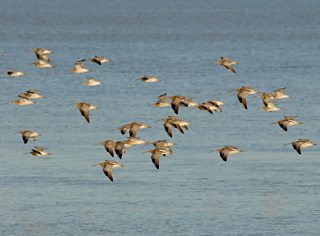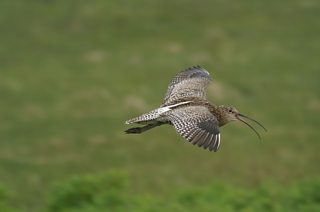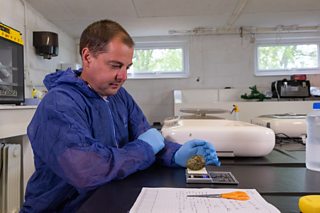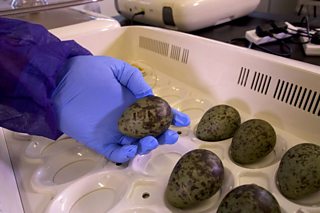Call of the curlew: what can be done to stop its decline?
WWT
Partner organisation of the Watches
By Peter Morris, Head of Communications at WWT
We are home to a quarter of the entire global population of curlew. If the curlew dies out in the UK, they are in real danger of disappearing from the earth all together. The scary news is that UK’s curlews are in serious decline. The British countryside is no longer a safe place for curlews to raise their young. With too few chicks surviving to fledge, there are not enough youngsters joining the population to replace the adults. We’re facing a future without our wader - that’s if nobody does anything about it.

Curlews fly over the water en masse. Photo by WWT.
Why curlews are wonderful
The curlew, and its smaller cousin the whimbrel, are the only two UK birds with long curved bills – like many tropical species. In fact its genus name – numenius – means ‘new moon’ in Greek, reflecting the elegant crescent shape of the bill that enables it to pierce mud or soil for food. But its amazing beak is too long for its tongue, so it has to pick up grubs as if it were using chopsticks and then toss them into the air, to fall into range of its tongue to guide the food in to be gobbled. It’s also the UK’s largest wader. Chicken-sized and long-limbed, it’s a wetland winged wonder.

The curlew's beak is one of its defining features, along with its relatively large size. Photo by WWT.
The sound of wild Britain
As distinctive as its bill undoubtedly is, it’s the curlew’s call which earns its ‘iconic’ moniker. To many, it’s a haunting – almost ghostly – rising sound that echoes the eeriness of Cornish estuaries or Yorkshire moors. It’s a romantic soundtrack to wild and windblown landscapes. To the less romantic, a group of curlews sounds rather like a kettle rising slowly towards the boil but never quite getting there. It’s a sort of bubbling sound which echoes beautifully around upland and lowland wetlands.
Threats to curlew
The curlew is a bellwether for ground-nesting birds. Their numbers are dropping and other species are following suit. It means something is out of kilter. It’s the lowlands where the curlews are disappearing the fastest. And WWT is one of many partners, organisations and individuals, standing together to make a difference for the curlew.
The reasons for its decline are as much guessed at as fully understood. As a ground-nesting bird, industrial farming machines could well be a problem for them. Empirically, generalist predators are also a problem to species with very small breeding populations – which leads us to ask why there are so many predators threatening them in the first place. And there is always the continual loss of wetland habitat to contend with, use of chemicals, and much more.
So WWT is beginning a long-term project to investigate the possible reasons for the species’ decline. We’ll consider all the factors and try to build a picture. In fact the search for reasons for the curlew’s plight could shine a light on a lot of other issues facing our countryside.

WWT are pioneering ways to save the curlew from its decline. Photo by WWT.
Headstarting the curlew
The trouble is, while we’re looking at long-term issues, the curlew itself continues to disappear and there’s a risk it could be too late before we take any action. This is where WWT’s unique position as both wetland conservation charity and a specialist bird breeder comes in. Visitors to our wetland centres will have already seen our living collections of wetland birds, the care for which gives us the knowledge and experience to take emergency action in the field where needed.
We’ve already saved the spoon-billed sandpiper in Russia, and the pochard of Madagascar, from next extinction by using a specialist rear-and-release technique known as ‘headstarting’. We’ve done the same for breeding European black-tailed godwits in England. Now it’s the curlew’s turn. With our technology and specialist care, we think we have a good chance of raising more chicks to fledge in the wild than their parents can naturally.
In fact, we’re very hopeful that we can stop the species from disappearing in the short-term, while we research its long-term outlook. We recently joined forces with the Ministry of Defence and Natural England to save dozens of curlew eggs from RAF airfields in an effort to repopulate lowland Britain with the threatened bird. Under normal circumstances, the eggs from nests near military runways are destroyed under licence to protect flight safety.
Instead, these eggs were transported to WWT Slimbridge in Gloucestershire to be hand-reared and released onto the Severn Vale. The plan is to hatch and rear them, and release them into the wild in areas where landowners want to help create the conditions for them to thrive. It’s hoped the new curlews will boost lowland population numbers in the area.
The great curlew fightback begins here. Watch this space.
.

The survival of each curlew egg could be crucial to the survival of the species. Photo by WWT.
